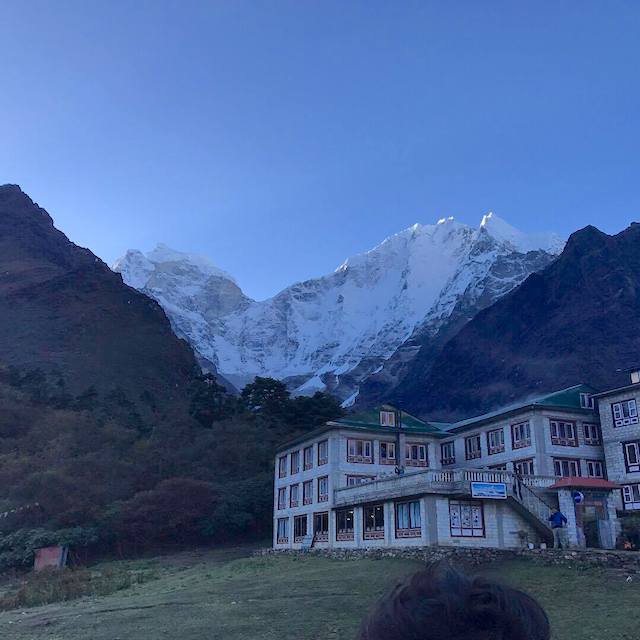
The mountains are calling, and I must go.
I’m sitting on my couch in the United States, nestled in the aroma of candles and strong incense with a background of gentle drums and singing bowls that wail deeply and resolutely through my speakers. If I close my eyes long enough, I can place myself back in Nepal.
It’s been a week since I’ve returned home. Nepal was such an overwhelming inspiration that I was sure I would begin to write about it immediately. However, I couldn’t write about it for a while, and I think it’s because there aren’t enough words in my vocabulary or abilities of expression with which to capture the essence of the trip and my experience there.
I didn’t want to create a review of the country that would fall to a laundry list of what to eat and where to sleep. If you’re searching for that kind of write-up, this isn’t it. Rather, this piece is about what Nepal taught me. After all, that’s why I joined a group of eight perfect strangers in a country I knew nothing about for 14 days.
The journey I joined was aptly named “Transformation Trek.” It is my belief now that you don’t leave Nepal in the same way that you came. Whether you’re seeking it or not, transformation finds you there—in the thickness of the mountain air.
The vastness of simple living and the crux of spiritual teachings and inward focus—pratyahara—comes upon you somewhere on some hilltop in the middle of your hike and takes you by surprise. I’ve often found myself in those moments, where nothing else existed but the mountains and me, devoid of any worry for what’s to come or what has already been. It was the present moment, just like that.
I hiked and practiced yoga with a group of men and women for two weeks. Each morning began with a gentle practice and a meditation, often outside on a cold mountain day. If we stepped on our mat with grassy feet, it was to symbolically step into our life without reservation that it was always going to be comfortable. Each and every class was a gift of surrender.
Before we rested for the night, an evening practice took us out of the elements and hiking rough terrain and back into our bodies. Nine tired souls, grounded on dirty mats in the heartbeat of the Himalayas, moving stiff joints with the breath, grunting, and laughing—the kind we do when we’re prying tight hamstrings open in the middle of a busy courtyard of other, non-yogi onlookers.
We became “the yoga people” on the trek. We didn’t mind. It’s what we were there to do—bring the practice we’d cultivated in toasty studios out into the kind of environment where it originated.
Nepal became the backdrop of our collective intentions as we moved with our breath that coupled with the mountain air, so vastly different from the kind we’re used to in our busy, dusty city streets. Our hikes, pushing us to exert our last drop of energy and strength as we climbed higher in altitude and stairs, reminded us of our fire—tapas.
A mantra quickly developed amongst our part, so resolute in the silence: we are so much stronger than we can even imagine. Hauling bags and our own bodies, and watching our porters do twice as much as the rest of us, became just as symbolic as our grassy feet on our yoga mats. What do we carry in life that is really worth the effort?
Through the hike, we would listen to the sounds of water, either trickling down the many waterfalls, cascading from the highest mountain top down to the lowest pool, or gushing in to merge with the Dudh Kosi river. The Dudh Kosi is almost white in appearance, hence the name “Milky River.” We couldn’t escape it. Through every hiking route or rest stop, it’s there, sounding its presence and giving the mountains its flow. In those moments of stillness and contemplation, where the air and the wind became the heartbeat of the mountain, water became its life-force, prana.
While many mornings and nights held their special magic in how we each experienced the class, one night in particular was especially divine. It was our first night in Phakding, the first tea house we stopped in to rest for the night. It was also the first night we experienced the evening chill, so far removed from the stark contrast of Kathmandu’s heat. Bundled up, we unfurled our mats in the courtyard right outside, and as the universe would have it, the lights went out and we were left to move in the dark.
I don’t think I was ever more thankful for a lack of electricity than in that moment, because what I saw laying in Savasana that day will remain a memory to tell my grandkids one day. A million and one stars. I counted. Behind us, a full moon nestled between two mountain peaks. In the light breeze, the countless strings of Buddhist prayer flags dancing in the wind, their frayed ends swirling and tangling, the mantras on their faces being sent out into the world, for the world.
Om Mani Padme Hum.
Each of the five flags represents an element: fire, water, air, earth, and ether. They serve as reminders that as we come from these five elements, we are deeply connected to nature and her ways, from the soles of our grounding roots to the heavens of our ethereal rays. I can’t speak for my fellow yogis, but I never felt more at peace with myself than in Savasana than on that starry night.
Each day and hike made us stronger and weaker at the same time. Stronger in that it pushed us to meet our bodies’ ability; weaker in that it allowed us space to release the real weight we carried: fear, rejection, hesitation, past hurt. We opened up to each other as we climbed higher, realizing that there was a pattern.
Each one of us was there for something. It wasn’t because we wanted a vacation. It wasn’t because we had nowhere else to go but Nepal. We each came to the trek with a chapter that needed to be written, and with a past that was perhaps a breaking of sorts. We were people with injuries, pain, endings, heartbreak, and loss, and each step we took on and off our mats was a re-direction toward an inner strength. One we maybe didn’t even know we had.
Over the span of 14 days, we created a community. Our community was rooted in the mountains of Nepal, but it stretched so much further than geography. The trip was a moment of learning. It wasn’t about what we could see or hear. It was about allowing Nepal to teach us how to receive. Through the mountains, Nepal took away all of the mundane tasks of living that we’re used to, and stuck us so deeply in the present moment that we had no other choice than to receive stillness, blessings, love, support, accountability, and most importantly, healing.
Our last hiking day was spent in silence. Sacred silence. Four hours of putting one foot in front of the other and being totally and irrevocably aware of doing so. Some people say that being alone with our thoughts for too long is dangerous. I think being alone with your thoughts is the most profound experience one can have. As we passed fellow trekkers who would nod their heads or say hello, we found ourselves at peace at not being able to answer them back.
Little Nepalese kids, with their bright red cheeks and beaming smiles, waving and squealing “namaste” our way was also a rich part of our experience. In our silent intention of not speaking back, we felt like all we could do was receive their good blessings. And for the first time, that felt good! It felt wholesome to not feel burdened by needing to reciprocate every single gesture, and from that single observation, an entire new mentality formed that I later wrote about on a rock looking out over Ama Dablam, a soon-to-become favorite mountain in the region. We are worthy of what we receive.
We are given so much in this world—compliments, love, support, attention, affection, opportunity. Even simple little gestures like smiles from beautiful kids are a gift. Do we really receive it, or do we often push it aside because we’re so intent on immediately giving that gift back?
We’ve lived our life with the subconscious decision that all that we receive is meant to be given back, reciprocated, and mirrored so as not to hurt others’ feelings. In those moments of sacred silence, our group learned that some of life’s most precious gifts are best left unreturned. We held them like pure light in our palms, knowing intuitively that this was our abundance to have and to keep. Perhaps this is a universal lesson in and of itself.
In receiving, we also find our healing. When we allow something larger than ourselves to creep in and take hold of our most beautiful and hurting parts, we shed thick layers of accrued fear and control, like metaphorical calluses. In that de-layering, not only do we find vulnerability within ourselves personally, but we find vulnerability collectively within groups and friendships. Our own sacred silence, whether through hard relationships or challenging life transitions, becomes a pulse we dive deeper into to uncover something much more stable. It’s often at the end of our allegorical hike that we discover something to receive, and something that makes any ordeal worth the climb in the end.
We are worthy of what we receive.
This world lays before us, with its open valleys and peaks, and it’s both our salvation and our biggest moment. It’s where we learn about ourselves through other people, by becoming a mirror that knows no barriers in language nor in custom. It’s where opportunities present themselves in the most uncontrolled of ways, and where our healing unfolds precisely because we’ve finally moved out of our own way and accepted that what comes to us is for us.
~
~
~
Author: Aleksandra Slijepcevic
Image: Author’s Own
Editor: Travis May
Copy Editor: Lieselle Davidson
Social Editor: Catherine Monkman

 Share on bsky
Share on bsky






Read 2 comments and reply